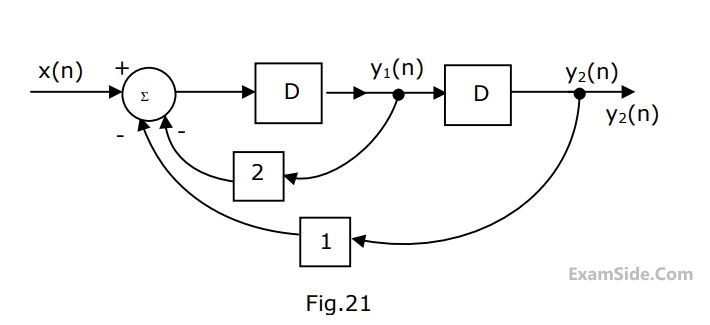1
GATE ECE 1997
Subjective
+5
-0
In Fig. 1, a linear time invariant discrete system is shown. Blocks labeled D represent unit delay elements. For $$n\, < 0,$$ you may assume that $$x\left( n \right),$$ $${y_1}\left( n \right),\,\,{y_2}\left( n \right)$$ are all zero.


(a) Find the expression for $${y_1}\left( n \right)$$ and $${y_2}\left( n \right)$$ in terms of $$x\left( n \right).$$
(b) Find the transfer function $${y_2}\left( z \right)/X\left( z \right)$$ in the $$z$$-domain.
(c) If $$x\left( n \right) = 1$$ at $$n = 0$$ or $$x\left( n \right) = 0$$ otherwise
Find $${y_2}\left( n \right).$$
2
GATE ECE 1996
Subjective
+5
-0
A system having a unit impulse response $$h\left( n \right)$$ = $$u\left( n \right)$$ is excited by a signal $$x\left( n \right)$$ $$ = \,{\alpha ^n}\,\,u\left( n \right).\,$$ Determine the output $$y\left( n \right)$$
3
GATE ECE 1996
Subjective
+5
-0
In the linear time-invariant system shown in Fig. 1, blocks labeled D represent unit delay elements. Find the expression for $$y\left( n \right),$$ and also the transfer function $${{Y\left( z \right)} \over {X\left( z \right)}}$$ in the $$z$$-domain.


Questions Asked from Discrete Time Linear Time Invariant Systems (Marks 5)
Number in Brackets after Paper Indicates No. of Questions
GATE ECE Subjects
Signals and Systems
Representation of Continuous Time Signal Fourier Series Fourier Transform Continuous Time Signal Laplace Transform Discrete Time Signal Fourier Series Fourier Transform Discrete Fourier Transform and Fast Fourier Transform Discrete Time Signal Z Transform Continuous Time Linear Invariant System Discrete Time Linear Time Invariant Systems Transmission of Signal Through Continuous Time LTI Systems Sampling Transmission of Signal Through Discrete Time Lti Systems Miscellaneous
Network Theory
Control Systems
Digital Circuits
General Aptitude
Electronic Devices and VLSI
Analog Circuits
Engineering Mathematics
Microprocessors
Communications
Electromagnetics